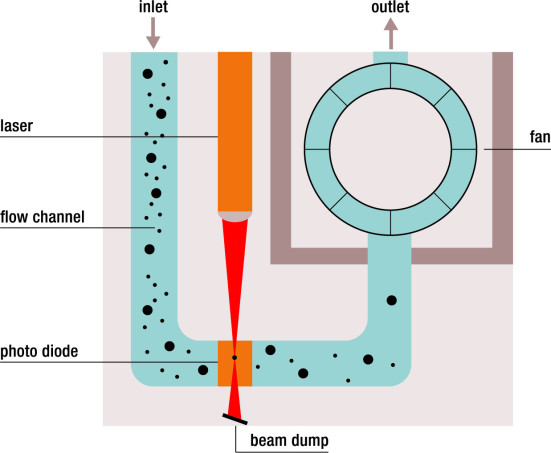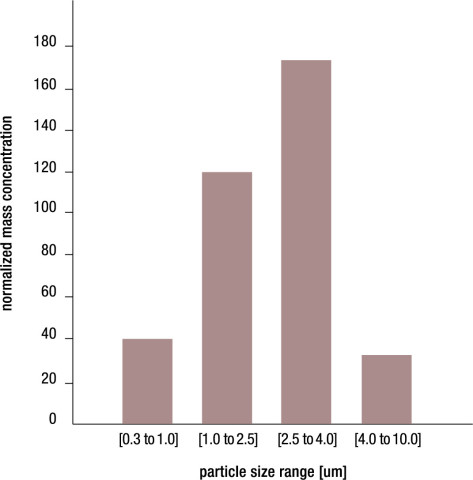Particulate Matter Sensing for Air Quality – Measurements
on
Sensirion’s dust resistance and advanced binning technologies provide added value to applications in several industries, including air quality monitoring, air purifiers and HVAC. A sensor that works over the whole lifetime of a device guarantees good air quality to the final user and increases energy efficiency and sustainable operation. Advanced binning and higher accuracy help to trigger specific actions based on the detected particle composition and improve the monitoring of filter lifetime based on the contaminant type information collected over the device’s operation.

Particulate Matter, abbreviated as ‘PM’, is a mixture of airborne solid particles and liquid droplets that can be inhaled and may cause serious health problems. PM includes particles with different characteristics — i.e. shape, optical properties, size and composition — but it is most commonly divided into sub-categories based on the particle size information.
Different PM categories are usually reported under the common nomenclature of PMx, where ‘x’ defines the maximum particle diameter in the airborne particle mixture or ‘aerosol’. For example, PM2.5 defines inhalable particles with a diameter of generally 2.5 micrometers and smaller, PM10 particles with a diameter of 10 micrometers and smaller, and so forth. The specific PM categories of PM10 and PM2.5 have been historically identified by national governments as important monitoring levels in order to assess the quality of the air we breathe, because PM10 particles irritate exposed mucous such as the eyes and throat and PM2.5 particles travel all the way through the lungs into the alveoli. New categories like PM1.0 and PM4.0 are also finding their way into air quality monitoring devices as these new outputs provide additional information to the traditional PM10 and PM2.5 levels, enabling a better particle pollution analysis and the development of new device-specific actions based on the detected aerosol type (e.g. house dust vs. smoke).
The common definition of PM includes particles that are no smaller than 100 nanometers in size. Particles smaller than 100 nm are instead reported as ‘ultrafine particles’ or ‘UFPs’ and are not covered in this article. Within the above-mentioned PM definition, which thus includes particles from 0.1 to 10 micrometers in size, the smaller the particles are, the deeper they can penetrate through our respiratory system and into our bloodstream, posing a higher hazard to our health. The World Health Organization (WHO) reports airborne particulate matter as a Group 1 carcinogen and as the biggest environmental risk to health, with responsibility for about one in every nine deaths annually. Figure 1 shows the size range of common pollutant sources, including filtration technologies used for the removal of such contaminants (adapted from John Wiley and Sons, Best Practices Guide to Residential Construction, 2006).

John Wiley and Sons, Best Practices Guide to Residential Construction, 2006).
Historically, PM values are measured as ‘mass concentration’ in μg/m3. The reason behind this is that the traditional and most accurate way to measure PM is the gravimetric method. This procedure makes use of a pre-weighed filter to collect ambient particles that are physically pre-sorted based on their size (e.g. all particles below 2.5 μm are let in). At the end of the sampling period, usually 24 hours, the filter is weighed to determine the total accumulated PM mass in μg. Mass concentration is then obtained by dividing the mass increase of the filter by the 24-hour total volume of air that passed through the filter, resulting in a value in μg/m3. Although gravimetric methods are long established as the most accurate way of determining mass concentration, they have some practical limitations to their diffusion in everyday applications: these instruments are bulky, very expensive, they process only one PM size per measurement (e.g. PM2.5), real-time sampling is not possible, and they cannot output the particle number count.
For these reasons, real-time optical particle counters (OPCs) have progressively found their way into the air quality monitoring market. These instruments are based on different optical principles, typically scattering or absorption, with light scattering being the most commonly used. In these OPCs, the particle passes through the light source (usually a laser beam) and causes scattering (or absorption) of the incoming light, which is then detected by a photodiode and converted into real-time particle count and mass concentration values.
Currently, optical detection is the most widespread technique due to its ease of use and unbeatable cost-performance ratio. In recent years, OPCs have become small enough to be integrated into air conditioners, air quality monitors and air purifiers, and are used to regulate and control air quality in households, cars and outdoor environments.
Although the basic principle of OPCs might seem simple at first from an implementation point of view, not all OPCs perform in the same way and the quality of their measurement depends greatly on the engineering and design of such devices. The optical principle works very well in terms of particle counting, but as these devices are used mainly for the estimation of the PM mass concentration, they will be susceptible to estimation errors due to the different optical properties of the particles (e.g. shape and color) and different mass densities. The quality of the mass estimation will thus vary highly depending on the manufacturer algorithm used to convert the measured optical signal into PM mass concentration. In addition, the internal airflow engineering has a high impact on the accuracy and drift of these sensors as particles can accumulate easily on their optical elements (laser, photodiode, beam-dump) and degrade their output over time if they are not properly engineered.
Working principle
The working principle of the Sensirion SPS30 is based on laser scattering. A controlled airflow is created inside the sensor by means of a fan. As shown in Figure 2, an internal feedback loop between the microprocessor and fan stabilizes the fan speed and therefore the airflow through the sensor. Environmental PM travels inside the sensor from inlet to outlet, carried by the airflow (black dots in Figure 3). In correspondence with the photodiode, particles in the airstream pass through a focused laser beam, as indicated in red in Figure 3, causing light scattering. The scattered light is then detected by the photodiode and converted to a mass/number concentration output through Sensirion’s proprietary algorithms, which run on the SPS30 internal microcontroller.

Particle composition recognition
As mentioned above, the manufacturer’s algorithms, together with a proper front-end electronics design, make a fundamental difference in the estimation of mass concentration from the detected scattered light. Most low-cost PM sensors on the market assume a constant mass density in calibration and calculate the mass concentration by multiplying the detected particle count by this mass density. This assumption only works if the sensor measures a single particle type (for instance, tobacco smoke), but in reality we find many different particle types with many different optical properties in everyday life, from ‘heavy’ house dust to ‘light’ combustion particles (see Figure 4).

Sensirion’s proprietary algorithms use an advanced approach that allows a proper estimation of the mass concentration, regardless of the particle type measured. In addition, such an approach enables a correct estimation of the size bins. Also, an additional bin output is provided in contrast to most state-of-the-art consumer PM sensors on the market — PM4.0. The increased accuracy for different aerosols and the higher resolution on the number of bins allows users to develop new use cases based on particle composition recognition. Figure 5 shows a practical demonstration of such a feature, using Sensirion’s Control Center software.

The bar charts show the real-time measured mass concentration bins, measured with an SPS30. The left chart shows a live measurement of match smoke, clearly richer in smaller particles. The right chart shows a measurement from Arizona dust, clearly richer in bigger particles. This simple but effective experiment highlights the value of the SPS30 advanced binning feature and the potential for the development of new applications based on particle composition detection.
Dust resistance
As mentioned previously a PM sensor is in principle very susceptible to output drift due to the accumulation of dust on the crucial optical parts of the device, namely the laser, the photodiode and the beam-dump (used to absorb the laser light and avoid parasitic scattering). Based on more than 20 years of experience in flow sensor design for several demanding markets and applications (e.g. automotive, medical, industrial and smart energy), Sensirion’s engineers have developed and integrated an innovative and proprietary flow path technology in the SPS30 that prevents dust and dirt accumulating on the optical components. The result of a stress test, where a sensor is exposed to the equivalent of five years’ dust exposure in Beijing, is shown in Figure 6.

The picture clearly shows that the flow path protects the crucial optical elements from dust exposure, and that the laser and photodiode are completely clean even after the stress test (the beam-dump, which is also protected from dust accumulation, is not visible in the photo).
(190241)➔ Do you want to read more ElektorLabs articles? Become an Elektor member now!


Discussion (0 comments)